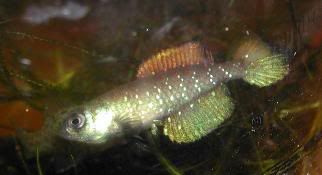And a female. I gave them a go at spawning today. They indeed are peat divers!




I seperated out 2 males to be fed extra and now they are coloring up. I've also got 2 females that I have been pampering. They do not seem very large but it could also be due to my relative inexperience in raising them and that I had some trouble getting them fed in that stage when BBS were not filling them up. Bad photos here. As you likely know they should be a purplish black base color.
~Joseph




And a female. I gave them a go at spawning today. They indeed are peat divers!
~Joseph




The spawning container(once a BBS hatcher).
Today I stuck both males in to see what would happen. Male on the left ended up victorious after intense displaying and some fighting, but nothing too serious. Impressive since he was the second male introduced after the first male had 2 dives with the female. Soon as he was in the first immediately challenged him. Afterward I removed the first male and left the male on the left in with the female. Guess I will be using him most frequently for breeding from here on out. Perhaps a way of selecting the better fish?
Dominant male, now trying to convince the female to give just a few extra eggs.

~Joseph



You might just be selecting the more aggressive one.

I usually spawn my annuals in groups and let them do their own selections.
I hope I maintain more genetic variability that way.
Erik Thurfjell
SKS 138, BKA 838-05, AKA 08998, SAA 251




LOL! Chances are though in group spawning the most aggressive male claims the bowl and then gets a monopoly on the females right? Unless you have seperate bowls for the males.
I have 2 pair in action right now with a few more not quite old enough. How big are your groups and what size tank are they kept in?
~Joseph



I think I have about 7 2-months old NGP in a small tank of only 8 litres.
May-be it is because of the crowded situation I don't spot any monopoly of the breeding coffee mug I use. But I get eggs alright.
Erik Thurfjell
SKS 138, BKA 838-05, AKA 08998, SAA 251




Interesting. Come this weekend I'll see about setting them up like that.
Also, does anyone have any opinions regarding this strain of nigripinnis? Someone I know claims that these are not a very good location of nigripinnis size/colorwise based off the breeders.
~Joseph

They look more like Austrolebias affinis instead of nigripinnis. There are several strains of nigripinnis and the best ones should give you a darker body colour that should appear pretty black along with silvery or bluish spots on the body.
There are many variants of this species circulating in the hobby and one of the nicest is from Arroyo Tajamar. Villa Soriano is a location in Uruguay but the fishes in your pics are not exactly the best of specimens I've seen that have been attributed to this particular population.
I suppose they are still young so give them a little more time to fully develop in terms of pattern and colouration. If you're using flash photography then the colours may not come out right. That may explain why they seem so differently coloured than the usual nigripinnis.
Fish.. Simply Irresistable
Back to Killies... slowly.




They have only recently colored up, so yes, quite young. Compared to many photos the spots also appear smaller.
The colors are indeed off but the fish are not "black" in life either. More like a purply grey color. My Elassoma evergladei are much darker than these guys right now.
What to make of this one here? I think these may be what Hellner was looking for. Sure hope they get into good hands.
http://www.aquabid.com/cgi-bin/aucti...she&1144787932
~Joseph

The males should get darker over time. That's a nice strain but I've not had much luck with eggs coming from South America so I'll skip. Good luck to whoever gets it.
Fish.. Simply Irresistable
Back to Killies... slowly.



I remember from my 1970-ies the same observation that Elassoma evergladei and BTW also my Aphanius mento sometimes could be much more sparkling than my NGP.Originally Posted by nonamethefish
Erik Thurfjell
SKS 138, BKA 838-05, AKA 08998, SAA 251

For Aphanius mento, usually the wild males originating from Turkey are the best coloured specimens. In captivity the males tend to lose the dark colours and turn more greyish and the bluish spots are not as bright.
Fish.. Simply Irresistable
Back to Killies... slowly.
Bookmarks